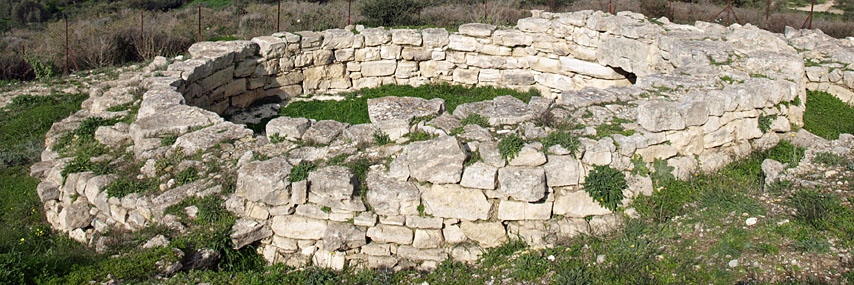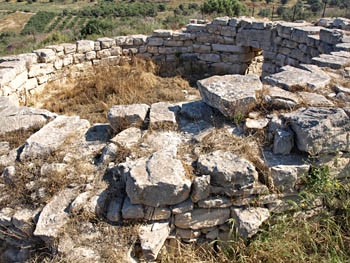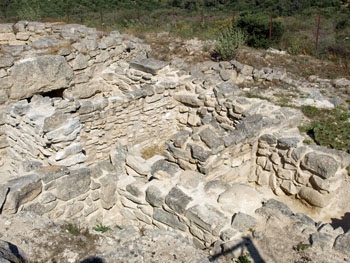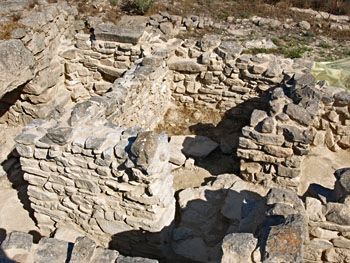
Tholos tomb with annexe
The Kamilari tholos tomb is located on a low hill near the sea and 1.9 kilometres south west of Ayia Triada and therefore also very close to Phaistos. The Kamilari tomb was the largest and best preserved of three tholos tombs found in the area when the Italian School carried out excavations in the area at the end of the 1950s.
The tomb was built in MM IB and continued in use throughout MM II until early in the Neopalatial MM III period. Indeed there is more material from MM III than from any other period in the tomb. It was also used for a time during LM I and then again in LM II, LM IIIAI and LM IIIA2, when Mycenaeans were thought to have occupied the island, after which it finally went out of use.
The protopalatial date for its construction is a very late date for the building of tholos tombs in this part of southern Crete. Most of them were built in the prepalatial period. Andrea Vianello writing in 2000, advanced some interesting theories, suggesting that the building of such a large tholos tomb in the Middle Minoan period might have been a challenge to the elite, now based in the first palaces, from a clan still rooted in the tradition of the Early Minoan tholos tombs, which he suggests were used by this previous elite to demonstrate their wealth and power.
He further argues that its continued use until the end of the First Palace period meant that the Palace elite was not able to completely overcome the power of the earlier agricultural elites in the Messara area of southern Crete. More will be said on the transition period from the first to second palace period below. The tomb then went out of use and was only reused in the period when a Mycenaean presence on the island is suspected. The Mycenaeans traditionally used tholos tombs for burial, but they also were challenging the elite of Minoan Crete, the elite of the palaces.
The tomb complex
The ground was levelled before the foundations of the tomb were laid. The internal diameter of the tholos tomb is 7.65 metres and the walls still stand to a height of two metres in places. The tomb does not have a trilitho (simple three stone) entrance but a built entrance, with a large capstone, all of which is very well preserved.
To the east of the tomb there is an annexe of five rooms. Room alpha, which encloses the entrance to the tomb and served as an antechamber, was linked to rooms beta and gamma by a short corridor. To the south there were two separate rooms, delta and epsilon, built as lean-tos against the rock. North of the five rooms of the annexe there was a paved area called the recinto delle offerte by the Italian excavators. The annexe was probably added soon after the construction of the tomb since all three areas -- the tholos tomb, the annexe and the open area all contained large quantities of MM II pottery.
Finds
The original excavator mentioned finding 500 vases of various types and 500 conical cups inside the tomb complex. However recent work at reconstructing pottery fragments from the tomb has now raised that total to 2500 of which 800 were conical cups. It seems that these handleless cups fall into two distinct groups dating to MM IIIA and MM IIIB respectively. From the MM IIIA period 400 drinking cups have been identified. Four basic styles of decoration were used on these cups and since the same four were also used on bridge-spouted jars it would appear that the cups and jugs formed distinct sets.
Other types of cups and jars with decoration distinctively different from the MM IIIA period which were found in the tomb have been allocated to MM IIIB.
The original number of 70 pouring vessels has now increased to 170 while the original figure of 70 stone vessels has now increased to 100. These were found in the tholos, room b and the external courtyard. Most are from the MM I and MM II periods. Tripod cooking pots were also placed in the main chamber as well as room b while a few examples were found in room g and the courtyard. These date from as early as MM II.
The nineteen seals found in the main tholos and room b date from the early protopalatial through to Late Minoan. The few precious objects found in the complex were also located in the main chamber and room b.
A substantial number of conical cups and many of the stone vases were found outside the tomb, on or around "The Offerings Enclosure". All of them had been placed upside down. It seems certain that these cups were used once only in a libation ritual. It is likely that a small number of close relatives of the dead would have drunk from these cups before placing them upside down. Branigan, who has made a major study of tholos tombs in the Messara region of southern Crete, concluded that some 400 to 500 people may have been buried in the Kamilari tomb over the centuries. It seems likely that from MM III onwards the area was used to dump pottery during cleaning of the tomb and annexe resulting in pottery from early periods appearing here. The main tomb would have been cleared of offerings to make room for new interments.
Based on these finds and their location within the complex, recent research suggests that the tholos chamber was the main area for burial while rooms beta and delta in the annexe were used for secondary burials. Rooms alpha and gamma and the connecting corridor were used for the placing of ritual equipment.
Clay models
The most interesting finds at Kamilari date from the LM IIIA burials, the last to be carried out here. Among the finds were three clay models depicting various scenes. One scene shows a banquet being offered to the dead. The religious nature of the event is clear from the horns of consecration and doves which have been attached to the clay model. The second scene shows two people standing in front of four seated people. It is possible that these two are making offerings to the dead. The final scene is of a group of dancers, dancing in a way which is very similar to the traditional Greek dances still to be seen on the island. These finds are on display in the Heraklion Museum.
There has been much discussion among archaeologists as to whether the tholos tombs of southern Crete had completely vaulted stone roofs or whether they were only partially vaulted and were then covered with wood or reeds. The amount of stone found collapsed into the tomb led the excavators to conclude that the tomb had been completely vaulted. A large stone was also discovered outside the area of the tomb and excavators suggested that this could have been the keystone which sealed the top of the tomb and that it had been removed by looters seeking access to the tomb. All of this seemed to suggest to the original archaeologists that the tomb at Kamilari, at least, was completely vaulted.
This interpretation has subsequently been questioned. Firstly not enough stones were found collapsed inside the tomb to account for a fully vaulted roof. (Although it is not impossible that local villagers removed stones from the site for use in construction work elsewhere as happened with other tholos tombs). Moreover there was no way of establishing that the large stone found outside the tomb really was a keystone. Much more likely, it was argued, was a partially vaulted roof with a wood or reed covering which could be removed for fumigating the tomb periodically. It has even been suggested that the partially vaulted tomb was left completely open to the elements at the top. Slabs of stone sticking out of the side of the outer wall of the tomb at regularly placed intervals may have been used by those charged with removing the wooden covering in order to allow fumigation to take place. Although their exact purpose cannot be stated for sure, they were certainly put there for a purpose given that they are not included in a random way in the outer walls.
Who was buried here?
Although once considered to have been linked to Phaistos, it now seems likely that the tombs at Kamilari were used by a settlement in the local area. Unlike some other tombs of the Mesara region, there was no move from communal burial to burial in pithoi or larnakes. Nor do there seem to be any presitigious burials of high ranking people. Does this suggest a more egalitarian approach by the community using this tomb? Were the settlements in this area organised in large family groups so that rank would not have been important in funeral customs? Or was the emphasis on community visible in the communal burials an attempt, as some argue, to hide the very real differences in status and rank that existed even in these small communities?
There is now a current of opinion which argues that after the destruction of the first palace at Phaistos, there was some sort of crisis linked to the failure of plans to replace it with a new palace in MM III and a shift in power away from Phaistos to Ayia Triada. The weakening of the power of Phaistos might then have allowed small communities like that at Kamilari, to become more autonomous and the political fragmentation could explain the failure to develop new funeral practices as was done elsewhere.
Although the tomb is fenced in, the gate is now left unlocked so it is possible to enter the site. Kamilari remains a very imposing structure and is well worth a visit. The views of the surrounding countryside are also quite spectacular.




